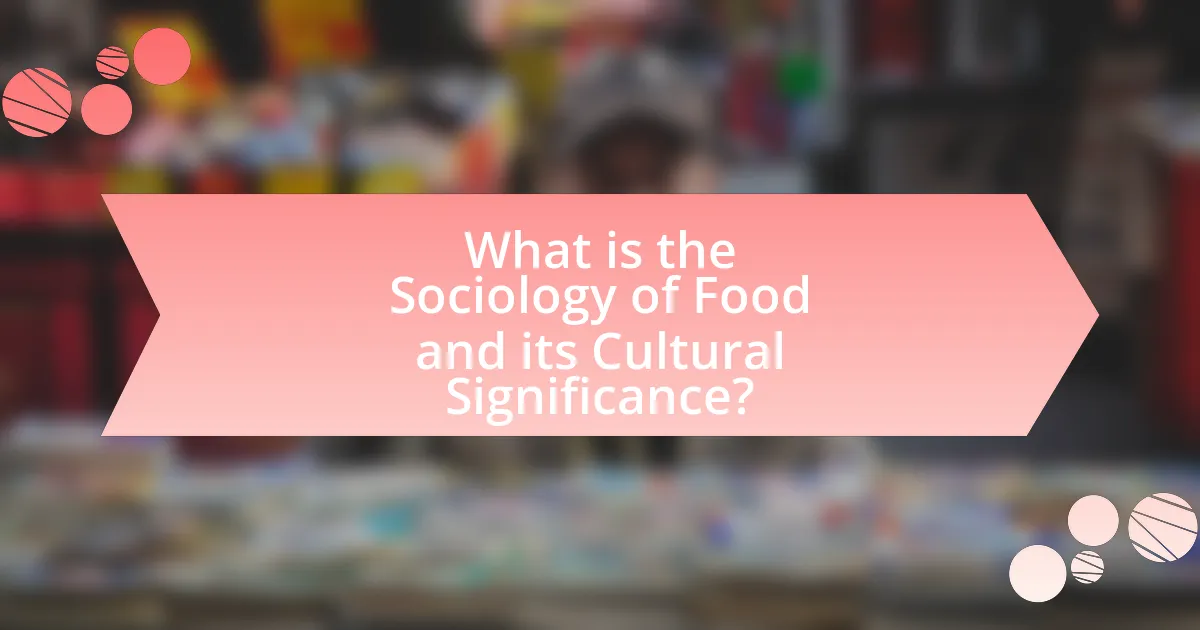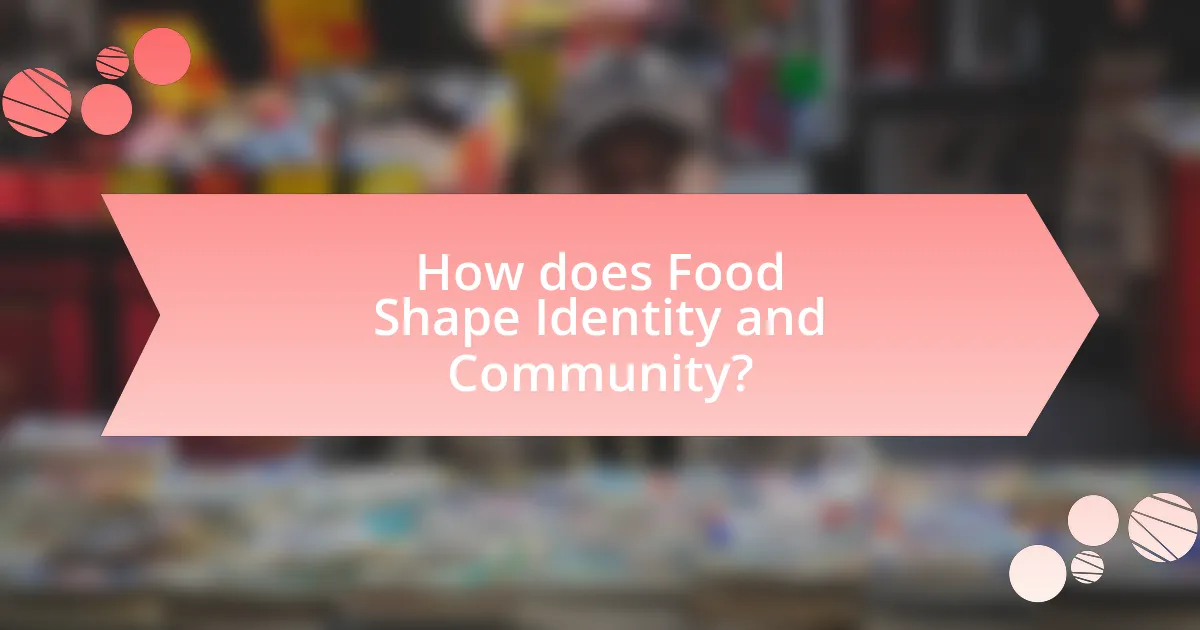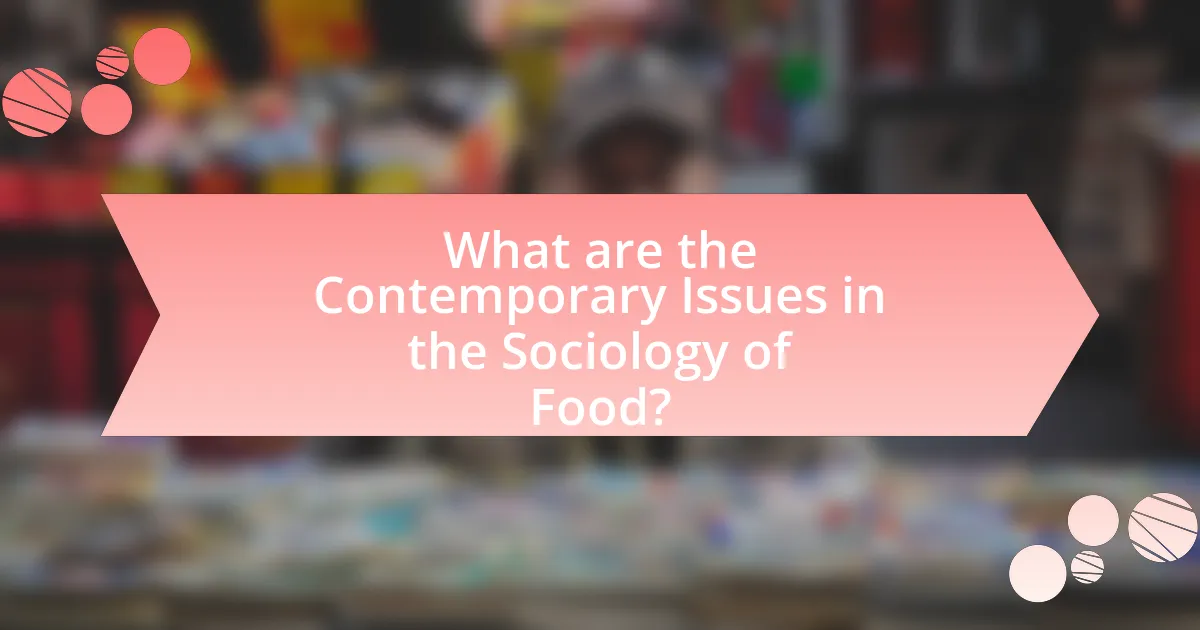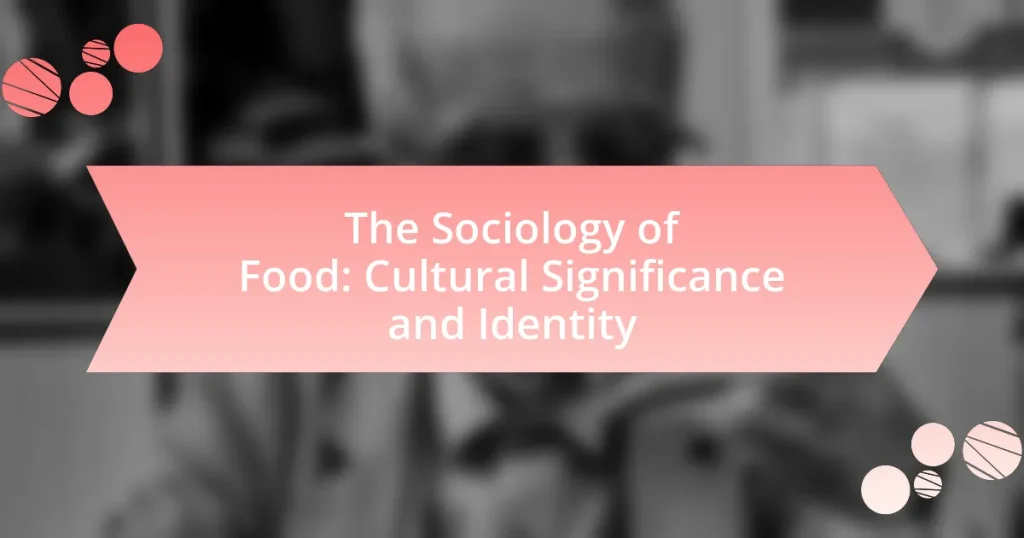The sociology of food examines the intricate relationships between food practices, cultural identity, and social dynamics within societies. This article explores how food reflects cultural heritage, influences social interactions, and serves as a marker of identity, while also addressing the impact of globalization, food security, and societal norms on dietary choices. Key theories in the sociology of food, such as the cultural theory and social construction of food, are discussed alongside the role of traditional cuisine in preserving cultural heritage. Additionally, the article highlights contemporary issues, including the effects of fast food and technology on food culture, and strategies for preserving food traditions within communities.

What is the Sociology of Food and its Cultural Significance?
The sociology of food examines how food practices and consumption reflect and shape social identities, cultural norms, and power dynamics within societies. This field explores the relationships between food, culture, and society, highlighting how factors such as class, ethnicity, and globalization influence dietary choices and food-related rituals. For instance, food can serve as a marker of identity, with specific cuisines symbolizing cultural heritage, while also acting as a medium for social interaction and community building. Research indicates that food practices can reinforce social hierarchies, as seen in studies showing that access to certain foods is often stratified by socioeconomic status, impacting health outcomes and cultural participation.
How does food reflect cultural identity?
Food reflects cultural identity by serving as a medium through which traditions, values, and social norms are expressed and preserved. For instance, specific dishes often symbolize historical events or cultural practices, such as the use of corn in Native American cuisine, which represents agricultural heritage and communal identity. Additionally, food rituals, such as communal meals during festivals, reinforce social bonds and cultural continuity, as seen in the celebration of Diwali in Indian culture where sweets are shared to signify prosperity and togetherness. Thus, food acts as a tangible representation of cultural identity, encapsulating the essence of a community’s heritage and collective memory.
What role does traditional cuisine play in cultural heritage?
Traditional cuisine serves as a vital component of cultural heritage by preserving and transmitting the values, beliefs, and practices of a community. It reflects historical influences, regional ingredients, and cooking techniques that define a culture’s identity. For example, UNESCO recognizes traditional food practices, such as the Mediterranean diet, as part of intangible cultural heritage, highlighting their role in fostering social cohesion and cultural continuity. This connection between cuisine and cultural identity is evident in rituals, celebrations, and daily life, where food acts as a medium for cultural expression and community bonding.
How do food practices vary across different cultures?
Food practices vary significantly across different cultures, reflecting unique traditions, beliefs, and environmental influences. For instance, in Japan, the emphasis on seasonal ingredients and presentation is evident in dishes like sushi and kaiseki, which prioritize aesthetics and freshness. In contrast, Mexican cuisine often features bold flavors and communal dining experiences, as seen in dishes like tacos and mole, which are integral to social gatherings. Furthermore, dietary restrictions based on religious beliefs, such as halal in Islam and kosher in Judaism, shape food practices and consumption patterns. These variations highlight how cultural identity and social structures influence what, how, and why people eat, demonstrating the intricate relationship between food and culture.
Why is food considered a social construct?
Food is considered a social construct because its meanings, values, and practices are shaped by cultural, social, and historical contexts rather than solely by biological needs. Different societies attribute various significance to food, influencing what is deemed acceptable, desirable, or taboo. For example, in many cultures, certain foods are associated with rituals, celebrations, or social status, illustrating how food choices reflect identity and community values. Research by sociologist Claude Lévi-Strauss highlights that food is not just sustenance but a medium through which social relationships and cultural narratives are expressed, reinforcing the idea that food practices are deeply embedded in social structures.
How do societal norms influence food choices?
Societal norms significantly influence food choices by shaping perceptions of acceptable and desirable eating behaviors. These norms dictate what is considered appropriate to eat based on cultural, religious, and social contexts. For instance, in many cultures, communal eating practices are valued, leading to shared meals that reinforce social bonds, while in others, individual dietary preferences may be prioritized. Research indicates that societal norms can also affect dietary restrictions, such as vegetarianism or veganism, which are often influenced by ethical beliefs and environmental concerns prevalent in specific communities. A study published in the journal “Appetite” by authors R. A. van der Lans et al. highlights how social influences, including family and peer groups, play a crucial role in shaping individual food choices, demonstrating that adherence to societal norms can lead to conformity in dietary habits.
What impact does globalization have on local food cultures?
Globalization significantly influences local food cultures by introducing diverse culinary practices and ingredients, often leading to the homogenization of food experiences. This process can diminish traditional food practices as global brands and fast food chains become more prevalent, overshadowing local cuisines. For instance, the rise of multinational fast-food chains has been linked to a decline in the consumption of indigenous foods in various regions, as seen in studies indicating that countries with higher exposure to global food brands experience a reduction in local dietary diversity. Additionally, globalization facilitates the exchange of food ideas and recipes, which can enrich local cuisines but may also lead to the loss of unique cultural identities tied to traditional food practices.
What are the key theories in the sociology of food?
The key theories in the sociology of food include the cultural theory of food, the social construction of food, and the political economy of food. The cultural theory emphasizes how food practices reflect and shape cultural identities, as seen in the diverse culinary traditions across different societies. The social construction of food theory examines how societal norms and values influence food choices and perceptions, highlighting the role of social context in determining what is considered acceptable or desirable to eat. The political economy of food theory focuses on the power dynamics and economic structures that affect food production and distribution, illustrating how global capitalism impacts local food systems and access to resources. These theories collectively provide a framework for understanding the complex relationships between food, culture, and society.
How do symbolic interactionism and structuralism apply to food sociology?
Symbolic interactionism and structuralism both significantly contribute to food sociology by examining how food practices shape and reflect social identities and structures. Symbolic interactionism focuses on the meanings individuals attach to food, such as how cultural rituals around meals create social bonds and convey identity, as seen in communal dining practices that reinforce group belonging. Structuralism, on the other hand, analyzes the broader social systems and structures that influence food production, distribution, and consumption, highlighting how economic and political factors shape dietary norms and access to food resources. For instance, structuralist perspectives reveal how socioeconomic status affects food choices and availability, illustrating the relationship between food and social stratification. Together, these frameworks provide a comprehensive understanding of the interplay between individual experiences and societal structures in the context of food.
What is the significance of food in social stratification?
Food plays a crucial role in social stratification by serving as a marker of class distinction and cultural identity. Different social classes have varying access to food types, quality, and quantity, which reflects and reinforces their socioeconomic status. For instance, higher socioeconomic groups often consume organic, gourmet, or specialty foods, while lower-income groups may rely on cheaper, processed options. This disparity in food access not only highlights economic inequalities but also influences social interactions and cultural practices, as food choices can signify belonging to a particular social group. Studies have shown that food preferences and consumption patterns are closely linked to social identity, with specific cuisines often associated with particular classes or ethnic groups, thereby perpetuating social hierarchies.

How does Food Shape Identity and Community?
Food shapes identity and community by serving as a medium for cultural expression and social bonding. It reflects individual and collective identities through traditional recipes, cooking methods, and communal meals that signify belonging. For instance, shared culinary practices often reinforce cultural heritage, as seen in festivals where specific dishes are prepared to celebrate cultural narratives. Research indicates that food-related rituals, such as family dinners or community feasts, foster social cohesion and strengthen interpersonal relationships, thereby enhancing community ties. Additionally, food choices can signal group membership, as seen in dietary practices that align with cultural or religious identities, further illustrating the integral role of food in shaping both personal and communal identities.
In what ways does food foster community bonds?
Food fosters community bonds by serving as a medium for social interaction and cultural exchange. Shared meals create opportunities for individuals to connect, communicate, and build relationships, reinforcing social ties. For instance, communal dining practices, such as potlucks or family gatherings, encourage collaboration and inclusivity, allowing diverse groups to come together and share their culinary traditions. Research indicates that communal eating can enhance feelings of belonging and strengthen community identity, as seen in studies highlighting the role of food in cultural festivals and local markets, where people engage in collective experiences centered around food.
How do communal meals strengthen social ties?
Communal meals strengthen social ties by fostering a sense of belonging and community among participants. When individuals share food, they engage in social interactions that promote bonding and trust, which are essential for building relationships. Research indicates that communal dining experiences can enhance feelings of connection and reduce social isolation, as evidenced by studies showing that families who eat together regularly report stronger emotional ties and improved communication. Additionally, shared meals often involve rituals and traditions that reinforce cultural identity, further solidifying social bonds within groups.
What role do food festivals play in community identity?
Food festivals play a crucial role in shaping community identity by fostering social cohesion and celebrating local culture. These events provide a platform for residents to come together, share culinary traditions, and showcase regional ingredients, which reinforces a sense of belonging. For example, studies have shown that food festivals often highlight local history and heritage, allowing communities to express their unique identities through food. Additionally, food festivals can attract tourism, further embedding the community’s cultural narrative in a broader context. This dual function of celebration and economic stimulation underscores the significance of food festivals in reinforcing community identity.
How does food serve as a marker of identity?
Food serves as a marker of identity by reflecting cultural heritage, social status, and personal values. Different cuisines and eating practices signify belonging to specific ethnic or cultural groups, as seen in traditional dishes that are passed down through generations, such as Italian pasta or Indian curry. Additionally, food choices can indicate socioeconomic status; for example, organic or gourmet foods may signal higher social standing. Research by sociologist Claude Fischler highlights that food is intertwined with identity, as it shapes social interactions and community bonds. Thus, food not only nourishes but also communicates who individuals are within their cultural and social contexts.
What are the implications of food choices on personal identity?
Food choices significantly influence personal identity by reflecting cultural, social, and individual values. These choices often serve as a means of expressing one’s heritage, beliefs, and lifestyle preferences. For instance, individuals who adhere to vegetarianism or veganism may identify with ethical considerations regarding animal rights and environmental sustainability, showcasing their commitment to these values. Additionally, food preferences can signal group membership, as seen in communities that celebrate traditional cuisines, reinforcing a sense of belonging and cultural identity. Research indicates that food practices are intertwined with social identity, as demonstrated in the work of sociologist Pierre Bourdieu, who emphasized the role of taste in social stratification. Thus, food choices are not merely about sustenance; they are integral to how individuals perceive themselves and are perceived by others within their cultural context.
How do dietary restrictions reflect cultural or religious identities?
Dietary restrictions serve as a significant reflection of cultural or religious identities by delineating the values, beliefs, and practices inherent to specific groups. For instance, in Judaism, the dietary laws of Kashrut dictate what foods are permissible, reinforcing a sense of community and adherence to religious commandments. Similarly, in Islam, the prohibition of pork and the requirement for halal food underscore the importance of obedience to divine law and cultural identity. These restrictions not only shape individual eating habits but also foster group cohesion and cultural continuity, as seen in the communal practices surrounding food preparation and consumption during religious observances.
What challenges do marginalized communities face regarding food identity?
Marginalized communities face significant challenges regarding food identity, primarily due to cultural dislocation, economic barriers, and systemic discrimination. Cultural dislocation occurs when traditional food practices are undermined or erased by dominant cultures, leading to a loss of heritage and identity. Economic barriers restrict access to culturally relevant foods, as many marginalized groups may live in food deserts where fresh, traditional ingredients are scarce or unaffordable. Systemic discrimination further exacerbates these issues, as policies and practices often favor mainstream food systems over those that support diverse cultural food identities. For instance, research by the Food Research and Action Center indicates that low-income communities, which often include marginalized populations, experience higher rates of food insecurity, limiting their ability to maintain their food traditions.
How does food insecurity affect cultural practices?
Food insecurity significantly disrupts cultural practices by limiting access to traditional foods and altering communal eating rituals. When individuals or communities face food scarcity, they often prioritize basic survival over cultural expressions tied to food, such as festivals, family gatherings, and traditional cooking methods. For instance, a study published in the Journal of Hunger & Environmental Nutrition found that food-insecure households are less likely to participate in cultural food traditions, which can lead to a loss of cultural identity and heritage. This shift not only affects individual families but can also diminish community cohesion and the transmission of cultural values associated with food.
What strategies do communities use to preserve food traditions?
Communities use various strategies to preserve food traditions, including intergenerational knowledge transfer, community cooking events, and the establishment of local food networks. Intergenerational knowledge transfer involves elders teaching younger generations traditional cooking methods and recipes, ensuring that cultural practices are maintained. Community cooking events, such as potlucks and food festivals, foster social connections and celebrate local cuisine, reinforcing cultural identity. Additionally, local food networks, including farmers’ markets and cooperatives, support the use of traditional ingredients and promote awareness of regional food heritage. These strategies collectively contribute to the sustainability of food traditions within communities.

What are the Contemporary Issues in the Sociology of Food?
Contemporary issues in the sociology of food include food security, globalization, sustainability, and cultural identity. Food security is a pressing concern as millions face hunger and malnutrition, highlighting disparities in access to nutritious food. Globalization affects local food systems, leading to the homogenization of diets and the loss of traditional food practices. Sustainability is increasingly critical as the environmental impact of food production and consumption becomes evident, prompting discussions on ethical eating and agricultural practices. Cultural identity is also significant, as food serves as a marker of cultural heritage, with globalization challenging traditional foodways and prompting movements to preserve local cuisines. These issues reflect the complex interplay between food, society, and culture in contemporary contexts.
How does the food industry impact cultural practices?
The food industry significantly impacts cultural practices by shaping dietary habits, influencing traditional cuisines, and altering social interactions around food. For instance, globalization has led to the widespread availability of diverse food products, which can result in the fusion of culinary traditions and the erosion of local food customs. A study by the Food and Agriculture Organization (FAO) highlights that the commercialization of food has transformed local eating habits, often prioritizing convenience over cultural significance. Additionally, marketing strategies employed by food companies can reinforce or reshape cultural identities, as seen in the promotion of fast food, which often supersedes traditional meals in various societies. This shift not only affects what people eat but also how they perceive their cultural heritage related to food.
What are the effects of fast food on traditional diets?
Fast food negatively impacts traditional diets by promoting unhealthy eating habits and reducing the consumption of local, nutritious foods. The prevalence of fast food leads to increased intake of processed ingredients, high levels of sugar, salt, and unhealthy fats, which can contribute to obesity and chronic diseases. Studies indicate that communities with high fast food availability often experience a decline in traditional food practices, as seen in research published in the journal “Appetite,” which highlights a correlation between fast food consumption and the erosion of cultural food identities. This shift not only affects individual health but also threatens the cultural significance and identity tied to traditional diets.
How do marketing and advertising shape food perceptions?
Marketing and advertising significantly shape food perceptions by influencing consumer attitudes and behaviors towards specific food products. Through strategic messaging, imagery, and branding, marketing creates associations between food items and desirable attributes such as health, convenience, or indulgence. For instance, studies show that advertisements featuring healthy foods often highlight their nutritional benefits, leading consumers to perceive these products as superior choices. Additionally, the use of celebrity endorsements and appealing visuals can enhance the desirability of certain foods, impacting purchasing decisions. Research published in the Journal of Consumer Research indicates that exposure to food advertising can alter taste perceptions, making consumers more likely to enjoy products they have seen advertised positively.
What role does technology play in food culture today?
Technology plays a crucial role in food culture today by transforming how food is produced, distributed, and consumed. Innovations such as precision agriculture, which utilizes data analytics and IoT devices, enhance crop yields and sustainability, directly impacting food availability and quality. Additionally, digital platforms like food delivery apps and social media influence dining habits and food trends, allowing for greater accessibility and diversity in food choices. For instance, a report by the Food and Agriculture Organization indicates that technology in agriculture can increase productivity by up to 70%, demonstrating its significant impact on food culture.
How has social media influenced food trends and identities?
Social media has significantly influenced food trends and identities by facilitating the rapid dissemination of culinary ideas and fostering community engagement around food. Platforms like Instagram and TikTok allow users to share visually appealing food content, which drives trends such as plant-based diets and gourmet home cooking. According to a study published in the journal “Appetite,” social media exposure has been linked to increased interest in diverse cuisines and healthier eating habits, as users are inspired by influencers and peers showcasing their meals. This digital interaction not only shapes individual food choices but also contributes to the formation of collective food identities, as communities rally around specific dietary practices and cultural cuisines, reinforcing social connections through shared culinary experiences.
What are the implications of food delivery services on communal eating?
Food delivery services significantly reduce communal eating by promoting individual consumption over shared meals. This shift impacts social interactions, as dining together traditionally fosters connection and community bonding. Research indicates that communal meals enhance relationships and cultural identity, while food delivery encourages solitary eating habits, leading to decreased social cohesion. A study published in the Journal of Consumer Research highlights that the convenience of food delivery often results in missed opportunities for social engagement, as individuals opt for solitary dining experiences instead of gathering with family or friends.
What practical steps can individuals take to honor food culture?
Individuals can honor food culture by actively engaging in traditional cooking practices and supporting local food producers. By preparing traditional recipes, individuals preserve culinary heritage and pass down cultural knowledge. Supporting local farmers and artisans fosters community connections and sustains regional food systems, which are vital for maintaining cultural identity. Additionally, participating in food festivals and cultural events allows individuals to experience and celebrate diverse culinary traditions, further reinforcing the importance of food culture in society.
How can one engage with local food movements?
One can engage with local food movements by participating in community-supported agriculture (CSA) programs, which connect consumers directly with local farmers. This involvement not only supports local economies but also fosters relationships between producers and consumers, enhancing community ties. Research indicates that CSAs can increase access to fresh produce and promote sustainable farming practices, contributing to food security and environmental health. By joining these initiatives, individuals actively contribute to the local food system and advocate for sustainable practices.
What are the best practices for preserving cultural food traditions?
The best practices for preserving cultural food traditions include documenting recipes, engaging in intergenerational cooking, and participating in community food events. Documenting recipes ensures that traditional methods and ingredients are recorded for future generations, as seen in initiatives like the “Heritage Recipe Project,” which collects and shares family recipes. Engaging in intergenerational cooking allows younger members to learn directly from elders, fostering a deeper understanding of cultural significance. Community food events, such as potlucks or festivals, promote sharing and celebration of diverse culinary practices, reinforcing cultural identity and community bonds. These practices collectively contribute to the sustainability and transmission of cultural food traditions.
